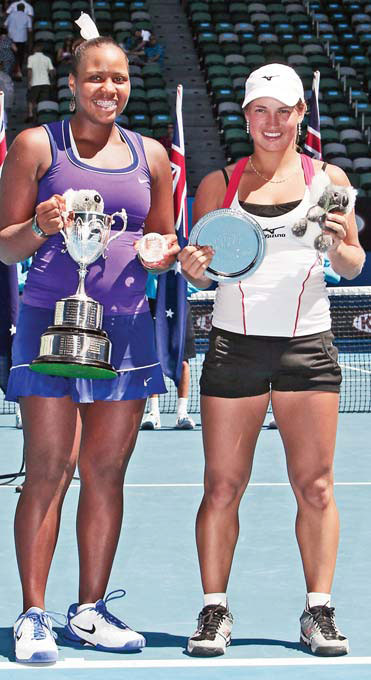Young Asian players on rise, but gap remains
Updated: 2012-01-29 08:01
By Sun Xiaochen(China Daily)
|
|||||||
|
Winner Taylor Townsend of the US (left) holds the trophy, along with runner-up Yulia Putintseva of Russia after the girls singles final at the Australian Open on Saturday. Compared to much stronger and more skilled Western players, Asian juniors still have work to do to catch up. Shuji Kajiyama / Associated Press |
MELBOURNE - Motivated by recent successes and a surge in interest, Asian junior tennis is riding a surge that could produce more players like Li Na and Kei Nishikori.
Appearing at her third Grand Slam junior event at the Australian Open, South Korean teen Jang Su-jeong was knocked out in the opening round, but she remains upbeat about her future on the tour.
"I felt very nervous although I played here last year. It's so special here at a major compared with other tournaments. Most of the juniors played so well here.
"I sort of opened my eyes and started to realize how high the world level is," the 16-year-old told China Daily through a translator outside the Rod Laver Arena.
Jang picked up a racquet at seven, inspired by her parents, and soon became one of South Korea's budding aces.
The Seoul native was among a group of 24 Asian boys and girls who traveled Down Under to test their skills against the rest of the world at Melbourne Park.
Sharing the venue and part of the spotlight with French open champion Li and rising Japanese star Nishikori inspired the youngsters.
"I admire Li's play, especially her power and speed. She's been the best representative for Asian tennis and has affected me a lot in terms of confidence and dedication," Jang said. "After her win (in France), I thought maybe I could do it one day."
Jang's mentor, Kim Il-soon, a former South Korean star, stressed the "Li Factor" has not only influenced China, but triggered the whole region's focus on nurturing talent.
"I was encouraged as well (after Li's epic French Open victory) and felt more responsibility to cultivate the kids," said Kim, who represented her country twice at the Olympics, in 1988 and 1992.
Success in the women's field has shown that the gap of conditioning is closing between Asian and Western girls.
Still, the often cited "body issue" should not be an excuse for Asian men any more as the pint-sized Nishikori has proved small men can do big things.
The Japanese stunned Spanish major semifinalist David Ferrer at the 2008 US Open and shocked the world by defeating world No 1 Novak Djokovic at a Swiss indoor event last November before outperforming French big-server Jo-Wilfried Tsonga twice recently.
His reaching the quarterfinals in Melbourne has set a standard for young male Asians to emulate.
"A lot of Japanese juniors feel really excited about his success. Kei is not so big, but when he beat some physical players, kids felt like they also had a chance to make it," said Ko Iwamoto, Japan's junior Davis Cup team captain.
Iwamoto, who was the mentor of former world No 4 Kimiko Date-Krumm, has paid close attention to the sport's development in Asia and has noticed a major performance slump when boy players turn to adults.
Despite a lack of players at the senior level, Asian junior tennis has emerged as a solid force worldwide in recent years. Japan grabbed the junior Davis Cup title in 2010 and South Korea claimed the Under-14 boys' singles championship last year.
However, this new Asian breed of players will continue to struggle on the pro tour due to a lack of professionalism and international experience, Iwamoto said.
"I don't think Kei's example can be emulated," Iwamoto said.
"He is unique. He lives in America with a crew of six trainers to support him. For the others in Japan it's hard.
"But we could at least make it closer to his pattern. We don't need to send them abroad at a very young age.
"We can train them domestically and travel around the globe for tournaments and short-term sessions."
Iwamoto's sentiments are echoed by Kim, who also emphasizes the value of Western training methods and overseas clinics.
Regularly exposed to the pro atmosphere, Japan's Kaichi Uchida, a boys' singles quarterfinalist at Melbourne, said he always watches and learns from the best.
"Staying together with top juniors from Europe and America, I can learn a lot from what they do before a match, on the court and even after the match in the gym," said Uchida, who made the semis at Wimbledon's junior event last year.
"Asian players seem less hungry on court; they have less fighting spirit. We are too shy to show off our character - like we never throw the racquets to release emotions as they (Western juniors) do.
"I think we should show more personality and this will help," said the 17-year-old.
The 1.80-meter teen said strong legs and skill are the keys to success for Asian boys and used Nishikori as a prime example.
"Watching him play gives me more energy and drives me to practice harder," said Uchida, who will attend a four-week clay-court camp in Brazil next week to prepare for the French Open junior tournament.
China Daily
(China Daily 01/29/2012 page8)
